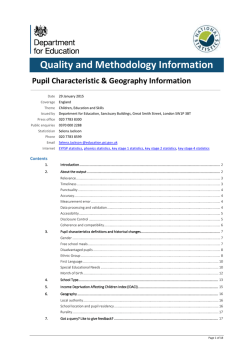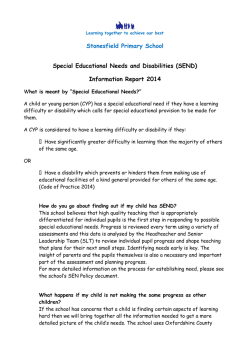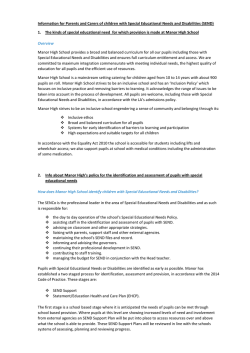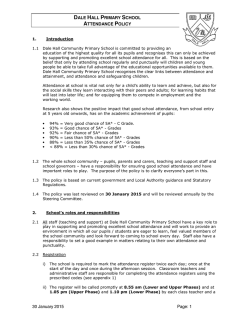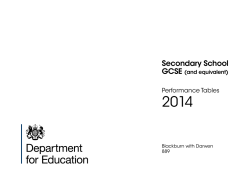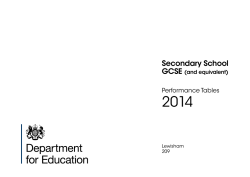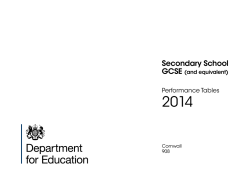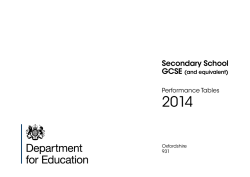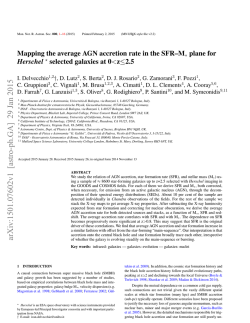
Methodology document: SFR02/2015
Quality and Methodology Information GCSE and equivalent results in England Date 29 January 2015 Coverage England Theme Issued by Children, Education and Skills Department for Education, Sanctuary Buildings, Great Smith Street, London SW1P 3BT Press office 020 7783 8300 Public enquiries Statistician 0370 000 2288 David Bartholomew Email [email protected] Internet Key stage 4 statistics Contents 1. 2. 3. 4. 5. 6. 7. Introduction .................................................................................................................................... 2 About the output ............................................................................................................................ 2 Data sources ..................................................................................................................................... 3 Relevance.......................................................................................................................................... 3 Timeliness ........................................................................................................................................ 5 Punctuality ....................................................................................................................................... 5 How the output is created............................................................................................................. 6 Derived variables ............................................................................................................................ 6 Data added from other sources ..................................................................................................... 8 Accuracy and reliability .............................................................................................................. 10 Data coverage ................................................................................................................................ 10 Measurement error ....................................................................................................................... 11 Validation and quality assurance of source data...................................................................... 12 Data Processing ............................................................................................................................. 12 Reliability ....................................................................................................................................... 13 Accessibility and Clarity............................................................................................................. 14 Disclosure Control ........................................................................................................................ 14 Coherence and comparability .................................................................................................... 15 Got a query? Like to give feedback? ........................................................................................ 17 Annex A: Process maps ................................................................................................................ 18 Annex B: Timeline of changes in key stage 4 attainment ........................................................ 19 A National Statistics publication National Statistics are produced to high professional standards set out in the National Statistics Code of Practice. They undergo regular quality assurance reviews to ensure that they meet customer needs. They are produced free from any political interference. Quality and Methodology Information: GCSE and equivalent results in England 1. Introduction This document provides a range of information on the quality of the key stage 4 attainment data and the methodology used in producing it. It is based on the Office for National Statistics’ guidelines for measuring statistical quality. It provides an overview of the data used in the production of the key stage 4 statistical first releases (SFRs) and the secondary school performance tables. It describes the methodology used to calculate pupil attainment in these publications. It provides information on the data sources, their coverage, their quality and how the data is validated and processed. 2. About the output National and local authority (LA) information on key stage 4 attainment of secondary school pupils in England is published in the following SFRs GCSE and equivalent results in England, 2012 to 2013 (provisional) GCSE and equivalent results in England, 2012 to 2013 (revised) GCSE and equivalent results by pupil characteristics in England, 2012 to 2013 GCSE and equivalent results in England, 2013 to 2014 (provisional) GCSE and equivalent results in England, 2013 to 2014 (revised) GCSE and equivalent results by pupil characteristics in England, 2013 to 2014 GCSE and equivalent results: SFR series School level information for the end of key stage 4 is published in the secondary school performance tables. National curriculum standards have been designed so that most pupils will progress by approximately one level every two years. For key stage 4 we assess the expected level of progress a pupil makes in English and in mathematics. This means that pupils who achieved level 4 at the end of key stage 2 would be expected to achieve grade A*-C by the end of key stage 4. All children in their final year of a key stage must be assessed. Most of the children will be in the year group with similarly aged pupils. For pupils reaching the end of key stage 4 it is typically those pupils starting the academic year aged 15. Page 2 of 20 Quality and Methodology Information: GCSE and equivalent results in England Data sources The key stage 4 datasets are compiled using information matched together from three data sources: i. Prior attainment records (key stage 2 results); ii. School Census records; and iii. Qualification entries and results collected from awarding bodies Attainment data for all pupils at the end of key stage 4 is collected from the awarding bodies by the department’s contractor. Relevance The key strength of the data is that it is derived from an administrative data collection. This means that it can supply accurate data down to small geographical areas (school level). In addition, the data is merged with other administrative data held by the department (the school census) to provide detailed information on sub-groups of the school population. Pupil level data from different key stages can also be merged so that we can produce precise measures of pupil progress between one key stage and another. Key users Department for Education Used to monitor national standards of key stage 4 attainment in secondary schools in England. The national figures are used to determine whether standards are improving or declining. Data for sub-groups of the population are also analysed to inform departmental policies aimed at closing gaps in attainment. School level figures are used to identify schools where intervention may be needed to bring standards up to an acceptable level. Ofsted Used as part of the background information to inform school inspections. For example, it enables inspectors to identify areas of the curriculum or groups of pupils where a school appears to be doing less well. This would then form part of the focus during the inspection. Ofqual Used as part of the evidence it reviews on the setting and maintenance of standards in key stage 4 examinations. Local authorities Use the national data and that for other LAs to set the attainment of their area into context. Use the school level information to hold maintained schools to account. Page 3 of 20 Quality and Methodology Information: GCSE and equivalent results in England Schools Used to evaluate their own performance against national standards and other local schools. Used to identify high performing schools with similar circumstances to their own that they can work with to improve their own standards. School governors Used to hold schools to account, to identify strengths and weaknesses and support school improvement. Teachers and head teachers Used to carry out analysis and self-evaluation, and to aid planning of school improvement strategies. Use the information to inform decisions about whether to apply for vacancies in particular schools and also as background information when preparing for interviews. Parents Used to compare their own children’s performance to others in their school, LA and nationally. Used to hold their children’s schools to account and identify areas where they feel the school needs to improve. Used to inform choice of a secondary school for their child. Performance of schools in the local area is also a key consideration for parents and prospective parents when moving house. Others Researchers from this country and abroad. Others use the information to identify schools with particular levels of attainment that they may wish to market their services to. Page 4 of 20 Quality and Methodology Information: GCSE and equivalent results in England Timeliness May and June Main GCSE examinations taken August The Joint Council for Qualifications (JCQ) collects results data from the awarding bodies JCQ publish GCSE results in the third week in August The department’s contractor receives results from the awarding bodies (data is collected throughout the year but the majority is collected in the summer) September Department receives provisional data from the contractor Secondary schools performance tables checking exercise October to December Provisional SFR published in October Scrutiny of amendment requests following checking exercise Department receives three sets of revised data during November and December January Revised SFR published alongside the secondary school performance tables February Post errata period commences for schools to request additional amendments to data March Department receives final data from the contractor and updates the performance tables Provisional key stage 4 results in England are published in October (23 October in 2014 – around six weeks after the department receives the provisional data from the contractor). Revised key stage 4 data including school level data and breakdowns by characteristics is published in January. Punctuality The proposed month of publication is announced on gov.uk at least twelve months in advance and precise dates are announced in the same place at least four weeks prior to publication. In the unlikely event of a change to the pre-announced release schedule, the change and the reasons for it would be announced. Page 5 of 20 Quality and Methodology Information: GCSE and equivalent results in England 3. How the output is created Data on pupil’s attainment is collected from awarding bodies via the department’s contractor. This information is linked with information on pupil’s characteristics taken from the school census and information on pupil’s prior attainment. This data is used to produce the provisional SFR. The data is checked with schools during the performance tables checking exercise. The revised pupil attainment data is then linked again with information on pupil’s characteristics and prior attainment to produce the revised/final datasets and all derived variables recalculated. This data is published in the revised SFR and the performance tables. Following publication of the performance tables, there is a short errata process where schools can inform us of any additional changes that should be made to the data. Following this process, the performance tables data is finalised and the performance tables website updated. The final data is used to update the time series in the following year’s SFR. This process is illustrated in the process map in Annex A. Derived variables A large number of variables are derived for publication in the key stage 4 SFRs and in the secondary school performance tables. A full list of the performance tables derived variables can be found in the metadata section of the website, available via the following link: Performance tables metadata The table below summarises key variables used in the publications. Total pupils Number of pupils at the end of key stage 4 Eligible pupils Used to identify the pupils to be included in school, LA and national level calculations. 5+ A*-C grades Number/percentage of pupils achieving 5 or more GCSEs or equivalent at grades A*-C 5+ A*-C grades (including English and mathematics) Number/percentage of pupils achieving 5 or more GCSEs or equivalent at grades A*-C including English and mathematics GCSEs Pupils making expected levels of progress in English or in mathematics Pupils included are those at the end of key stage 4 with valid key stage 2 test results or teacher assessments. The measure of expected progress is built on the principle that pupils achieving a level 4 in English or in mathematics by the end of key stage 2 should be expected to achieve at least a C grade at GCSE in that subject. Further guidance can be found at: Progress measures guidance Page 6 of 20 Quality and Methodology Information: GCSE and equivalent results in England English Baccalaureate (EBacc) Pupils entering and achieving a core of selected academic subjects which are English, mathematics, sciences, a humanities subject (history or geography) and a language. A list qualifications included in the English Baccalaureate is available at EBacc List Low/middle/high prior attainment Pupils are grouped based on their performance at key stage 2, averaged across qualifying outcomes in English, mathematics and science tests or teacher assessments. Indicators are shown for: Low attainers = those below the expected level (level 4) at key stage 2 Middle attainers = those at the expected level (level 4) at key stage 2 High attainers = those above the expected level (level 4) at key stage 2 Further guidance can be found on: Defining high, middle and low attainers Average point score (APS) The key stage 4 average point score awarded for GCSEs are set out in the table below: Grade Points A* 58 A 52 B 46 C 40 D 34 E 28 F 22 G 16 Ungraded 0 The capped point score is based on a pupil’s best 8 GCSE or equivalent results. Page 7 of 20 Quality and Methodology Information: GCSE and equivalent results in England Data added from other sources Characteristics Information on pupil characteristics is taken from the school census. Details will be provided in a separate quality and methodology document when 2014 breakdowns by characteristics are published. School Admission Basis The school admission basis is taken from Edubase and is given as at 11 September at the start of the academic year. They are defined as follows: Comprehensive schools Takes all pupils, usually regardless of their ability, aptitude or whether they have been selected for a place at a selective school. Modern schools Takes pupils regardless of their ability or aptitude, including those who have not been selected for a place at a local selective school. Selective schools Admits pupils wholly or mainly with reference to ability. These schools were formally designated as grammar schools. School Type The school types are taken from Edubase and are given as at 11 September at the start of the academic year. They are defined as follows: Academy Sponsor Led Sponsored academies are all-ability, state-funded schools established and managed by sponsors from a wide range of backgrounds, including high performing schools and colleges, universities, individual philanthropists, businesses, the voluntary sector, and the faith communities. Academy Converter Schools that have chosen through Governing Body Resolution and application to the Secretary of State to become an academy under the Academies Act 2010. Free School Free Schools are all-ability state-funded schools set up in response to what local people say they want and need in order to improve education for children in their community. They have the same legal requirements as academies and enjoy the same freedoms and flexibilities. Studio School Studio schools are all-ability and mixed sex state funded schools, independent of local authorities. They are an innovative new model of educational provision, delivering mainstream qualifications through practical project-based learning. They are not extensions or conversions from existing provision, but are new 14-19 academies, typically with around 300 pupils. Page 8 of 20 Quality and Methodology Information: GCSE and equivalent results in England University Technical College (UTC) UTCs are all-ability and mixed sex state funded schools, independent of local authorities. They are not extensions of or conversions from existing provision, but new 14-19 Academies, typically with 500-800 pupils. UTCs specialise in subjects that need modern, technical, industry-standard equipment, such as engineering and construction, and teach these disciplines alongside business skills and a broad, general education. Pupils integrate academic study with practical learning, studying core GCSEs alongside technical qualifications. City Technology College (CTC) Independent all-ability, non-fee-paying schools offering pupils the opportunity to study a curriculum geared, with the help of private sector sponsors, towards the world of work. There are currently only three CTCs as most have converted to sponsor led academies a few years ago. LA maintained school Schools fully or partially under LA control that are state-funded, mainly by the Dedicated Schools Grant. These include community schools, foundation schools, voluntary aided school and voluntary controlled schools and also LA maintained special schools. Registered independent school Any school which provides full time education for 5 or more pupils of compulsory school age, which is not state-funded or a non-state-funded special school. Independent special school Approved by the Secretary of State for Education. They are run on a not-for-profit basis by charitable trusts and normally cater for children with severe and/or low incidence special educational needs. This group includes non-maintained special schools. State-funded school Includes LA maintained schools, academies, free schools, City Technology Colleges and state-funded special schools (excluding hospital schools, pupil referral units, alternative provision and independent schools). State-funded mainstream schools Includes LA maintained mainstream schools, academies, free schools, City Technology Colleges (excluding all special schools, pupil referral units, alternative provision and independent schools). State-funded special schools Includes LA maintained special schools, academy sponsor led special schools, academy special schools and special free schools. All independent Includes independent schools, independent special schools and non-maintained special schools. Page 9 of 20 Quality and Methodology Information: GCSE and equivalent results in England Pupil referral unit (PRU) A PRU is established and maintained by a local authority which is specially organised to provide education for children who are excluded, sick or otherwise unable to attend mainstream school and is not a special or other type of school Alternative Provision (AP) Alternative provision takes place when a LA takes direct responsibility for the education of a young person who is unable to attend a mainstream school. Common reasons for a young person receiving alternative provision include exclusion, medical needs or school refusal. 4. Accuracy and reliability Data coverage The target population for the key stage 4 data collection is all pupils who are at the end of key stage 4, typically those pupils starting the academic year aged 15. We produce a provisional SFR based on the provisional data covering headline national and local authority information only. It does not contain any characteristics breakdowns (other than gender) as these are more subject to change, particularly at LA level. We update this SFR with revised data early the following year when the school level information is published in the performance tables. During the September checking exercise schools are able to apply for pupils to be removed from their figures, if they have recently arrived from overseas and their first language is not English. Although these pupils will be removed from the revised school and LA figures, they remain included in the national figures so that these reflect the attainment of all pupils. Other reasons a school may remove pupils are if a pupil has been admitted following a permanent exclusion from another school, if the pupil is not at the end of key stage 4, if the pupil has permanently left England, the pupil has left the school before exams or the pupil is deceased. Schools cannot be accountable for these pupils and therefore we allow the removal of them so they are not included in their performance measures. Schools cannot remove pupils in certain circumstances for example; pupil has been excluded from school after the January school census, the pupil left to go to another school in England, the pupil is a persistent non-attender. A separate SFR is published at the same time which includes characteristic breakdowns such as ethnicity, special educational needs and first language. There are a small number of further changes to the data following publication of the performance tables. The performance tables (national, LA and school level figures) are updated with these changes but the SFR is not updated because the extent of the changes does not usually affect the national or LA figures. However the final data will be used to update any time series in the following year’s statistical first release. Page 10 of 20 Quality and Methodology Information: GCSE and equivalent results in England Measurement error Clear guidance is provided to schools regarding the administration of the GCSE papers, including instructions for keeping the exam materials secure prior to the exams and storage of completed papers until they are collected for marking. The exam papers are externally marked by the awarding bodies to ensure that marking is consistent between schools. There are no quotas set or underlying assumptions about the proportion of pupils who should be at each grade. Proportions are decided entirely by how pupils’ attainment measures up to the standards of the exams. After marking, results are returned to schools. If schools have concerns over the marking of an exam paper, they may request for it to be re-marked. Outcomes of appeals are not reflected in the provisional data but are included in the revised data. Further information on the general regulations for conducted/marked can be found on the JCQ website: schools and how exams are Joint Council for Qualifications (JCQ) website Ofqual sets the standards and rules that awarding bodies need to meet when they design, deliver and award regulated qualifications. They monitor awarding bodies and qualifications to make sure that standards are maintained. They are a risk-based regulator and concentrate their resources to where they are most needed. For example, they may discover that an awarding body’s processes need updating or that there are risks connected to a qualification taken by thousands of students every year. Further guidance on the role of Ofqual can be found at: How Ofqual regulate Performance tables checking exercise As a further check of the accuracy of the underlying data, the key stage 4 data is also collated into school level information and shown to schools, together with the underlying pupil data during the performance tables checking exercise. Schools are required to check the data and notify the department of any pupils that are included in their school in error, or of any missing pupils. Schools can also notify us of any other errors in the data such as errors in matching prior attainment results. Any changes requested are validated to ensure that they comply with the rules before being accepted. They are also able to apply for pupils to be removed from their figures, if they have recently arrived from overseas and their first language is not English. We allow the removal of these pupils from the school and LA figures as they can have an impact on some schools figures (since some schools have significant numbers of such pupils). However, we continue to include these pupils in the national figures so that they reflect the attainment of all pupils. Schools can also apply for pupils to be removed if a pupil has been admitted following a permanent exclusion from another school, if the pupil is not at the end of key stage 4, if the pupil has permanently left England, the pupil has left the school before exams or the pupil is deceased. Page 11 of 20 Quality and Methodology Information: GCSE and equivalent results in England Following the checking exercise the revised data is produced. This includes changes requested by schools during the checking exercise, changes resulting from any successful marking reviews and any late results. The data is then published in the revised key stage 4 SFR and in the secondary school performance tables. Approximately 60 per cent of schools took part in the 2014 results checking exercise. Following publication of the performance tables, some schools notify us of further changes required in the data. These changes are validated in the same way as those which are received during the checking exercise and a final dataset is produced at the end of March. Updates are made to reflect any changes to data published in the performance tables but the SFR is not updated. Validation and quality assurance of source data Once schools have completed their key stage 4 exams they are required to send their exam materials and attendance registers to the awarding bodies for external marking and data capture. Key stage 4 results are made available to schools on results day. In 2014 this was 21 August. This data is then passed from the awarding bodies to the department’s contractor for processing and then onto the department for use in the SFRs and performance tables. Data Processing Key stage 4 data received from awarding bodies are combined with pupil characteristics from the school census and prior attainment by the department’s contractor. Records are matched, using fields such as surname, forename, date of birth, UPN, gender and postcode. This successfully matches around 98% of results. At every stage in the data cycle, the department checks all calculations used in the production of the figures. The department carries out checks on the data to ensure that the files produced by the contractor comply with the specified format and contain the correct information. All indicators at school level, local authority level and national level are re-derived to ensure the contractor’s systems are programmed correctly. The entire process is subject to a ‘dry run’ during the summer. This involves producing a dummy dataset, from the previous year’s dataset, which conforms to how the current year’s data will be supplied (eg if new qualifications have been introduced, then dummy data would be added to last year’s data to simulate these). This dummy dataset is used to test the contractor’s systems and the department’s checking processes. This allows potential problems to be resolved prior to the receipt of the live data. Page 12 of 20 Quality and Methodology Information: GCSE and equivalent results in England Statistical first release production All data in the SFR tables is dual run by two people with independent methodologies. Any discrepancies in the data produced are discussed and resolved prior to publication. Further quality assurance is carried out on the data produced. Examples of further quality assurance Comparisons with previous year’s figures to identify any large unexpected changes Comparisons with provisional data to identify any large changes (revised/final data only) Check totals are consistent across tables Check patterns in the data (eg expected differences between subjects, high/low performing local authorities) Check figures against those produced for the performance tables Reliability The key stage 4 data can change between provisional and revised data as the revised data contains: outcomes of the appeals process where schools ask for reviews for one or more of their pupils in the belief that a clerical error has been made or the mark scheme has not been correctly applied late results changes resulting from requests from schools to remove pupils who have recently arrived from overseas, have been admitted following a permanent exclusion for another school, if the pupil is not at the end of key stage 4, if the pupil has permanently left England, the pupil has left the school before exams or the pupil is deceased However, the national figures usually change by no more than plus or minus one percentage point between provisional, revised and final data. Table 1 shows the change in some key figures at national level over the last three years. Table 1: Change in national key stage 4 data All schools Percentage of pupils achieving 5 or more GCSEs or equivalent at grades A*-C (including English and mathematics): 2011/12 2012/13 2013/14 Provisional 58.6 58.6 52.6 Revised 59.4 59.2 - Final 59.4 59.2 - Changes in the LA figures can be slightly larger and changes in school level data can be greater still. As a result of the large level of change in school figures, school level results are not published based on provisional data. Changes in LA and school level data between revised and final data are small. Page 13 of 20 Quality and Methodology Information: GCSE and equivalent results in England 5. Accessibility and Clarity The SFR text is published in pdf format so that it is accessible to all users irrespective of their choice of software. Care is also taken to ensure that the document meets accessibility guidelines. Key figures are highlighted in the SFR text which draws out the key messages such as changes over time and differences between groups of pupils. Small tables or charts illustrating key figures are also included in the text. Each SFR is accompanied by formatted Excel tables with clear titles which allow general users to find more detail than can be provided in the SFR text. Any important limitations or inconsistencies in the data are mentioned in footnotes so that users do not have to refer to the text or this document. Where there are large numbers of tables, these are split into manageable sections (eg national tables in one file, LA tables in a separate file) so that users do not need to download larger files than necessary for their needs. The performance tables website provides a number of ways of searching for schools of interest (eg by name of school, by town, within x miles of a postcode or all schools within a LA) and presents the data in a series of web pages showing different aspects of the data. The selected schools are shown in alphabetical order by default but can be sorted by any measure if the user requires ranked data. Users can also download the data for all schools in either Excel or csv format. Key stage 4 information also forms part of the national pupil database (NPD) which is an education dataset holding a wide range of information about pupils and students and has provided invaluable evidence on educational performance to inform independent research, as well as studies commissioned by the department. Any user wishing to conduct more detailed research or analysis may request an anonymised pupil level extract of the national pupil database (NPD). Disclosure Control The Code of Practice for Official Statistics requires us to take reasonable steps to ensure that our published or disseminated statistics protect confidentiality. In the statistical first releases, an ‘x’ indicates that a figure has been suppressed due to small numbers. Values of 1 or 2 or a percentage based on 1 or 2 pupils who achieved, or did not achieve, a particular level are suppressed. Some additional figures have been suppressed to prevent the possibility of a suppressed figure being revealed. This suppression is consistent with the departmental statistical policy on confidentiality. In the school level data, any figures relating to a cohort of 5 pupils or fewer will be suppressed. This applies to sub-groups of pupils as well as the whole cohort, for example, if there were five boys and three girls in a school, we would not publish attainment for boys or girls separately but would publish attainment for all pupils (as this is based on 8 pupils). Page 14 of 20 Quality and Methodology Information: GCSE and equivalent results in England 6. Coherence and comparability We use the same methodology to produce the data within our SFRs and the performance tables. We also use a dataset produced at the same time for the performance tables and the revised SFR. As a result, the national and LA figures included in both the revised SFR and the performance tables will match. There have been some changes to key stage 4 data which can make comparisons over time difficult. These changes are listed in annex B. Where time series are shown in the tables, any discontinuities will be indicated in the tables by the use of a dotted line and footnotes will be included to explain the reason for the discontinuity. Where possible (for example, when methodology rather than test structures change), figures for previous years will be recalculated using the current methodology. For the major changes in 2014 the figures haven’t been recalculated but information has been provided based on different methodologies to give users some statistics for comparison. There were major changes to key stage 4 data in 2014. These are listed below: Wolf Review In 2014, secondary school performance measures will be calculated significantly differently following the implementation of the Wolf review recommendations1. The review set out a number of recommendations for the reform of the secondary school performance tables from 2014, including: Only include qualifications in performance measures which meet the new quality criteria. This has led to the removal of around 3,000 unique qualifications from the performance measures between 2012/13 and 2013/14. A full list of the qualifications that can count in 2013/14 performance measures can be found here: inclusion of 14-16 qualifications in 2014 Adjust the associated point scores for non-GCSEs so that no qualification will count as larger than one GCSE in size. For example, where a BTEC may have previously counted as four GCSEs it will now be reduced to the equivalence of a single GCSE in its contribution to performance measures Restrict the number of non-GCSE qualifications that count in performance measures at two per pupil To ensure that all pupils are provided with access to a broad and balanced curriculum, the number of approved non-GCSE qualifications counting towards secondary school performance measures will be capped at two qualifications per pupil, affecting both threshold and point score measures. In line with Professor Alison Wolf’s recommendations2 the department has published a list of qualifications that will count in the secondary school performance tables for 14-16 year olds in 2014, 2015 and 2016. The list of qualifications that will count in the 2014 performance tables can be found at Key stage 4 performance tables 2014: eligible qualifications and List of all qualifications included in the 2014, 2015 and 2016 performance tables 1 2 Professor Alison Wolf published her review of vocational education in March 2011: Professor Alison Wolf's review Professor Alison Wolf's recommendations Page 15 of 20 Quality and Methodology Information: GCSE and equivalent results in England Discounting will be employed against the list of qualifications that will count in the 2014 performance tables. In general, qualification discounting ensures that, where a pupil has taken two or more qualifications with an overlap in curriculum, the secondary school performance tables only give credit once for teaching a single course of study. Discounting may be required in a number of situations, for example: a pupil resits a qualification before the end of key stage 4, possibly with a different awarding body. Discounting then ensures that only one result is counted in the secondary school performance tables calculations and measures the school provides a single course of study but then enters the pupil for two or more very similar qualifications. Discounting ensures that the achievement from this single set of teaching hours is counted only once For further information on the new discounting rules, along with specific scenarios of how the policy will be applied and the specific handling of English, mathematics and science qualifications, please see the following guidance, 2014 discounting guidance New early entry rules New ‘early entry’ rules for key stage 4 qualifications have been introduced, which will affect the 2014 key stage 4 SFRs and the secondary school performance tables. On 29 September 2013 the Secretary of State announced that, from this date, only a pupil’s first entry to a key stage 4 qualification counts towards their school’s performance measures. The early entry rule will apply even where qualifications are taken with one exam board and then retaken with another. This new rule does not prevent schools from entering pupils for examinations before the end of key stage 4. Pupils can sit an examination more than once but it will be their first certificated grade in that subject that will be used for performance measures. The early entry rules will be applied to all performance measures. This includes the percentage of pupils achieving at least 5 or more A*-C GCSEs including English and mathematics, and the English Baccalaureate. The early entry rules will only apply to English Baccalaureate subjects in 2014. These subjects are: English (English, English language, English literature) mathematics science history geography modern and ancient foreign languages For all other subjects, performance measures will continue to count the best entry a pupil has in that subject. From 2015 onwards all subjects will be affected. For further information on the new early entry rules, along with specific scenarios of how the policy will be applied, please see the following guidance: Early entry guidance Page 16 of 20 Quality and Methodology Information: GCSE and equivalent results in England The Welsh Government, Scottish Government and the Department for Education Northern Ireland (DENI) publish similar attainment data for schools. Further information is available on their websites: Welsh Government website Scottish Government website Department for Education Northern Ireland (DENI) website 7. Got a query? Like to give feedback? If from the media Press Office News Desk, Department for Education, Sanctuary Buildings, Great Smith Street, London SW1P 3BT. 020 7783 8300 If non-media David Bartholomew, Education Data Division, Department for Education, 2 St Paul’s Place, 125 Norfolk Street, Sheffield S1 2FJ. [email protected] Page 17 of 20 Quality and Methodology Information: GCSE and equivalent results in England Annex A: Process map Page 18 of 20 Quality and Methodology Information: GCSE and equivalent results in England Annex B: Timeline of changes in key stage 4 attainment 2009/10 Publish % attaining the new English Baccalaureate. Publish % attaining the “Basics” (A*-C English and maths). Count accredited IGCSEs (and their precursors) for first time. 2010/11 GCSE only measures introduced to performance tables. AS levels counted in English Baccalaureate. 2011/12 First cohort to know of English Baccalaureate measure when making course choices. 2012/13 New biology, chemistry, physics and additional science GCSEs. Marks awarded for spelling, punctuation and grammar in English literature, history, geography and religious studies exams. 2013/14 Wolf Review recommendations come into force in performance tables: • Only Wolf-approved qualifications counted • Each equivalent of one GCSE only • No more than two non-GCSE qualifications • New discounting rules Only first attempt at GCSEs etc. counts in performance tables and in English Baccalaureate subjects. GCSEs no longer unitised (modular) but linear. New GCSE geography exam. Page 19 of 20 Quality and Methodology Information: GCSE and equivalent results in England © Crown copyright 2014 You may re-use this information (excluding logos) free of charge in any format or medium, under the terms of the Open Government Licence. To view this licence, visit Open Government Licence or e-mail: [email protected]. Where we have identified any third party copyright information you will need to obtain permission from the copyright holders concerned. Any enquiries regarding this publication should be sent to us at Jayne Middlemas, Education Data Division, Department for Education, 2 St Paul’s Place, 125 Norfolk Street, Sheffield S1 2FJ. 0114 2742117 [email protected] This document is also available from our website. Page 20 of 20
© Copyright 2024


